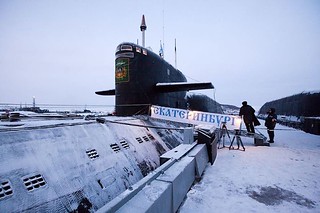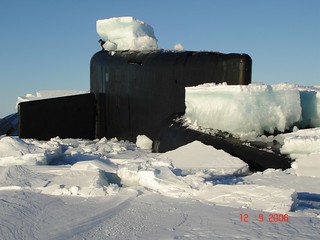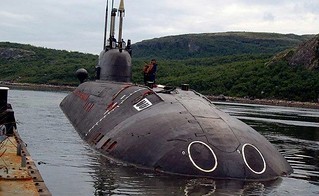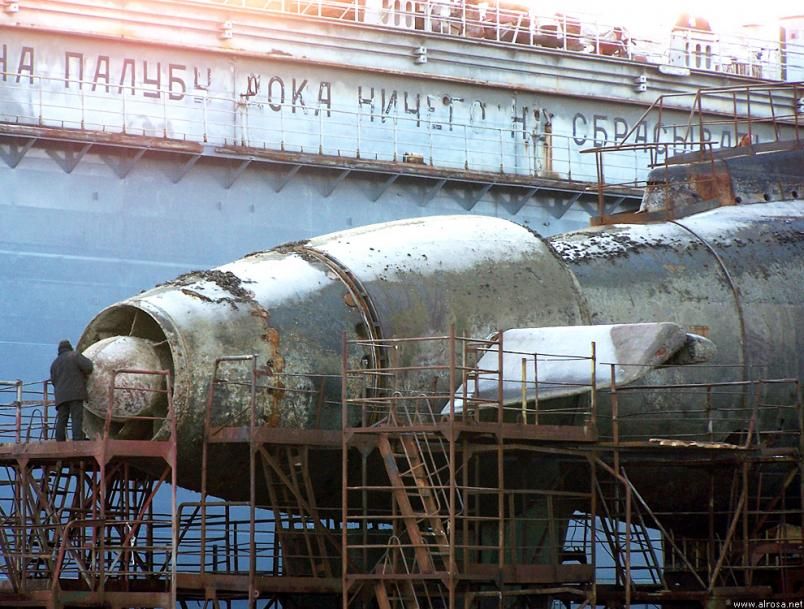Soviet tactics differed throughout the years, the Soviet and now Russian navies have been based around the submarine even back to the 30's what you find it that while the Soviets led the field in some aspects technologically speaking they are some what behind and that's even today.
50's and 60's were more about power projection the first class of submarine launch in 1957 the November class were on paper superior to Nautilus in many respects, the K3 and her sisters could out run and out dive the Nautilus with ease after all Nautilus was a conventionally hulled vessel where as the K3 adopted a cigar shape hull.
 K3
K3 by
Blair shaw, on Flickr
This is the actual K3 Leninsky Komsomol the first nuclear powered submarine for the soviet union
What set them apart was what made that fight particularly interesting, while the Soviet boat can out run and out dive the Nautilus she herself had a far superior sensor kit which meant she heard the opponent coming long before she herself was detected with that in mind it does mean that right there even with speed and depth the Nautilus had some advantage.
What we see in the Soviet navy between the early 50's right to mid 70's is a concept of open ocean engagement and by around 76 the Soviets realised that despite the numbers they would loose in this realm to the better equipped NATO forces.
When you look at Soviet boats specifically the 1st and 2nd generations they are somewhat clumsy looking the Echo lived up to its name that was one noisy boat for sure, but it had a weapon that was not yet placed fully onto western vessels and that was the cruise missile.
A scout vessel would go ahead this would be an older boat normally a diesel like a whiskey or Zulu class and act as a radar picket for a fleet (we saw this in 1961 during operation Okean)
 IMG_0268
IMG_0268 by
Blair shaw, on Flickr
This is a Zulu IV class SSK and she is the only one left in existence the scout vessels would have been modified much like the Whiskey Canvas bag types we saw in the early 1960's
The scouts would highlight the incoming targets normally a carrier group and the Echo and Juliette would fire their missiles at a distance (normally the SS-N-3c Shaddock) and run away.
Today we saw the progression first from the Echo to the Charlie classes and to the present day the Massive Oscar II which has 24 SS-N-19 Shipwreck missiles, they will be progressed most likely by a SSGN version of the Yasen class armed with SS-N-26 Oniks
 Oscar II SSGN
Oscar II SSGN by
Blair shaw, on Flickr
As you can see this is one huge submarine and the square hatches you see are for the Missiles side mounted in pairs like a Slava has
The West did learn a lot about Russian made weapons in the 60's especially when the SS-N-2 Stynx missile hit and sunk the Israeli destroyer Elait it did accelerate western adoption of anti ship and anti air weapons its also led us to the anti missile missile systems we see today including the Phalanx, Goal keeper and AK130's
The first and second generation of submarines had inferior sensors so the drill was to for a barrier search ahead of any surface unit and use active sonar to drive away any NATO submarines, the Soviets were aware that there was a gap and they were trying to close it this is a big reason why you see so many different types of ASW units in the Soviet and now Russian navies it also shows you the importance they place on the submarine not only developing them and going all out to do so but also the anti submarine weapons that they deploy.
Come the 1980's a lot of the submarines from the 50's and earlier in some cases are obsolete the Russians knew they could not compete platform for platform so realised that the only way was by a tactic called sea denial.
As we can see today the Russian navy has few major surface platforms with a handful of large Cruisers and Destroyers and one single heavy aviation cruiser (Kuznetsov) again the Emphasis is on ASW we see that the Sovrenemmy which is a primary ASuW AAW platform some of which have been retired early yet the tandem unit the ones they operate along side for ASW purposes the Udaloys have not, We also see the Grisha Krivack classes all alive and well yet others like the Kresta and Kara's have long since been deleted.
We look to current builds and find that the Admiral Gorshkov, Neutashimmyy, and Buryan M are all mainly ASW ships.
The Soviet navy come late 70's started to realise that their submarines were not up to the task and retreated into a Bastion concept and by this time they have the platforms and weapons to be able to do so.
If you look at the earlier Yankee class the missile has a range of only around 1200-1600 miles it means that the submarine must run the GIUK and SOSUS gauntlet in order to deploy likely attracting the attention of a following NATO submarine, with the Advent of the Delta III and its very advanced version the Delta IV
 Delta IV SSBN
Delta IV SSBN by
Blair shaw, on Flickr
This is K84 Ekateringburg at Zapadnya Litsa on the Kola Peninsular
coupled with the Typhoons we then see a shift chance no more do we see open ocean deployments because weapons like the SS-N-20 and SS-N-23 can hit mainland america from their bases and thus eliminated the need for them to go to sea.
They found a new home under the ice and the noise the ice makes helps mask the ambient noise in some cases a submarine makes so it was a no brainier for the Soviets the design of the Typhoon reflects this greatly missiles forward and a very heavily reinforced sail which can puncture through 3 meter thick ice
 Delta IV SSBN in the Arctic ice
Delta IV SSBN in the Arctic ice by
Blair shaw, on Flickr
 Delta IV SSBN in the Arctic ice
Delta IV SSBN in the Arctic ice by
Blair shaw, on Flickr
This gives you some idea just how thick the Delta IV can break through
Now being under the ice means you have a few advantages but also some disadvantages, the Americans deploy the MK48 ADCAP torpedo and yes it is a brilliant weapon and a weapon the Russian do want to get hold of it is fully capable under ice to counter this the Russians prefer to stay outside the range of the MK48 and thus use the SS-N-16 Stallion which is similar to ASROC however you cannot fire it under the ice so in this field for me personally the American MK48 and the British Stingray have all the advantage.
Dispite being twin screwed both Typhoons and Delta IV's are said to be very quiet not quite to the level of the Ohio or Vanguard but almost there thanks to the above mentioned John Walker.
With the theft of the secrets the Russians called a halt to the Victor II production and developed the Victor III and later the Victor IV (heavily modified Victor III)
 Victor IV ssn
Victor IV ssn by
Blair shaw, on Flickr
B414 Danill Moskoviskky pulling into port she is one of the later Victor IV and still in commission
The Victor III / IV and first batch of Akula's are en par in the realm of noise making as the 688i that a qu]antum leap, what walker also did is give them the keys to better their sonar systems, and we see this with the advent of the MGK-503 coupled with the Skat 3 (later Skat 3M and today it is the Barracuda M) towed sonar array which meant they had almost the same ability as western boats for passive detection, the only thing they lacked is a waterfall display system which does mean they are still disadvantaged.
Later boats with the help of Toshiba (who gave the Russians plans for new screw designs and tools to build them) from the late 70's would be rendered quieter with the new propellers and later Pump jets which we see on the Project 877V Kilo class Alrosa
 Borrowed this from the net to explain the point this is Alrosa in Dry Dock in the Black sea showing her Pumpjet quite nicely
Borrowed this from the net to explain the point this is Alrosa in Dry Dock in the Black sea showing her Pumpjet quite nicely
But in all cases the shift is clear the current Batch coming along such as Borei class use this technology, as does the American Seawolf Virigina classes the British Trafalgar and Astute so the Russians are still there just not in the numbers.
In the 80's Things did change Gorshkov died and a lot of boats such as the earlier first generation submarines were paid off grossly overdue in many cases, the Russians never really grasped the concept in the way the Americans do their whole ethos is based around sea denial and all the designs even today reflect this.
The tactics used have gone head over heels since the 60's but the primary use for the Russian fleet is to stop Amphibious landings and Submarine insertion it is also to protect the Nuclear Missile submarines hence why the Project 971 Akulas were hurried through production even in bankruptcy in the late 90's.
That said the role changed in the early 80's from one of open ocean offensiveness to close to home defensiveness after the realisation they couldn't match the west platform to platform.
The tactics employed such as crazy ivan are not needed any more given that the towed array is present on nearly all their current submarines and that goes for the 80's too a lot of boats did get retrofitted and in fact HMS Conqueror and Later HMS Splendid did retrieve two towed sonar arrays the Conks from some Polish Trawlers the Splendid from the back of a typhoon.
When i get more time i can call out some books i have that detail using drawings the tactics used by the Soviets not just in the 50's and 60's but also up to the 80's.